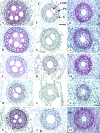Dosage effect of the short arm of chromosome 1 of rye on root morphology and anatomy in bread wheat
- PMID: 20444906
- PMCID: PMC2882260
- DOI: 10.1093/jxb/erq097
Dosage effect of the short arm of chromosome 1 of rye on root morphology and anatomy in bread wheat
Abstract
The spontaneous translocation of the short arm of chromosome 1 of rye (1RS) in bread wheat is associated with higher root biomass and grain yield. Recent studies have confirmed the presence of QTL for different root morphological traits on the 1RS arm in bread wheat. This study was conducted to address two questions in wheat root genetics. First, does the presence of the 1RS arm in bread wheat affect its root anatomy? Second, how does root morphology and anatomy of bread wheat respond to different dosages of 1RS? Near-isogenic plants with a different number (0 to 4 dosages) of 1RS translocations were studied for root morphology and anatomy. The F(1) hybrid, with single doses of the 1RS and 1AS arms, showed heterosis for root and shoot biomass. In other genotypes, with 0, 2, or 4 doses of 1RS, root biomass was incremental with the increase in the dosage of 1RS in bread wheat. This study also provided evidence of the presence of gene(s) influencing root xylem vessel number, size, and distribution in bread wheat. It was found that root vasculature follows a specific developmental pattern along the length of the tap root and 1RS dosage tends to affect the transitions differentially in different positions. This study indicated that the inherent differences in root morphology and anatomy of different 1RS lines may be advantageous compared to normal bread wheat to survive under stress conditions.
Figures





Similar articles
-
Integrated genetic map and genetic analysis of a region associated with root traits on the short arm of rye chromosome 1 in bread wheat.Theor Appl Genet. 2009 Sep;119(5):783-93. doi: 10.1007/s00122-009-1088-0. Epub 2009 Jun 21. Theor Appl Genet. 2009. PMID: 19544051 Free PMC article.
-
Dissection of QTL effects for root traits using a chromosome arm-specific mapping population in bread wheat.Theor Appl Genet. 2011 Mar;122(4):759-69. doi: 10.1007/s00122-010-1484-5. Epub 2010 Dec 11. Theor Appl Genet. 2011. PMID: 21153397 Free PMC article.
-
Structural rearrangements in wheat (1BS)-rye (1RS) recombinant chromosomes affect gene dosage and root length.Plant Genome. 2021 Mar;14(1):e20079. doi: 10.1002/tpg2.20079. Epub 2021 Jan 18. Plant Genome. 2021. PMID: 33463018
-
[Conjugation of the 1BL/1RS translocation with qualitative and quantitative traits in the common wheat T.aestivum].Tsitol Genet. 2001 Sep-Oct;35(5):74-80. Tsitol Genet. 2001. PMID: 11944320 Review. Russian.
-
Regulation of root growth and elongation in wheat.Front Plant Sci. 2024 May 21;15:1397337. doi: 10.3389/fpls.2024.1397337. eCollection 2024. Front Plant Sci. 2024. PMID: 38835859 Free PMC article. Review.
Cited by
-
Can we improve heterosis for root growth of maize by selecting parental inbred lines with different temperature behaviour?Philos Trans R Soc Lond B Biol Sci. 2012 Jun 5;367(1595):1580-8. doi: 10.1098/rstb.2011.0242. Philos Trans R Soc Lond B Biol Sci. 2012. PMID: 22527401 Free PMC article.
-
Prioritizing quantitative trait loci for root system architecture in tetraploid wheat.J Exp Bot. 2016 Feb;67(4):1161-78. doi: 10.1093/jxb/erw039. J Exp Bot. 2016. PMID: 26880749 Free PMC article.
-
QTL mapping and phenotypic variation of root anatomical traits in maize (Zea mays L.).Theor Appl Genet. 2015 Jan;128(1):93-106. doi: 10.1007/s00122-014-2414-8. Epub 2014 Oct 19. Theor Appl Genet. 2015. PMID: 25326723
-
Expression Patterns Divergence of Reciprocal F1 Hybrids Between Gossypium hirsutum and Gossypium barbadense Reveals Overdominance Mediating Interspecific Biomass Heterosis.Front Plant Sci. 2022 Jul 1;13:892805. doi: 10.3389/fpls.2022.892805. eCollection 2022. Front Plant Sci. 2022. PMID: 35845678 Free PMC article.
-
Introgression of novel traits from a wild wheat relative improves drought adaptation in wheat.Plant Physiol. 2013 Apr;161(4):1806-19. doi: 10.1104/pp.113.214262. Epub 2013 Feb 20. Plant Physiol. 2013. PMID: 23426195 Free PMC article.
References
-
- Aloni R, Griffith M. Functional xylem anatomy in root-shoot junctions of six cereal species. Planta. 1991;184:123–129. - PubMed
-
- Barlow PW. The cellular organization of roots and its response to the physical environment. In: Gregory PJ, Lake JV, Rose DA, editors. Root development and function. Cambridge: Cambridge University Press; 1987. pp. 1–26.
-
- Böhm W. 1979. Methods of studying root systems. Ecological Studies Vol. 33. Wallingford: CAB International.
-
- Bowen GD, Rovira AD. Recent advances in plant nutrition. Vol. 1. New York: Gordon and Breach Science Publishers Inc. USA; 1971. Relationship between root morphology and nutrient uptake; pp. 293–305.
-
- Ehdaie B, Whitkus RW, Waines JG. Root biomass, water-use efficiency, and performance of wheat-rye translocations of chromosomes 1 and 2 in spring bread wheat ‘Pavon’. Crop Science. 2003;43:710–717.

